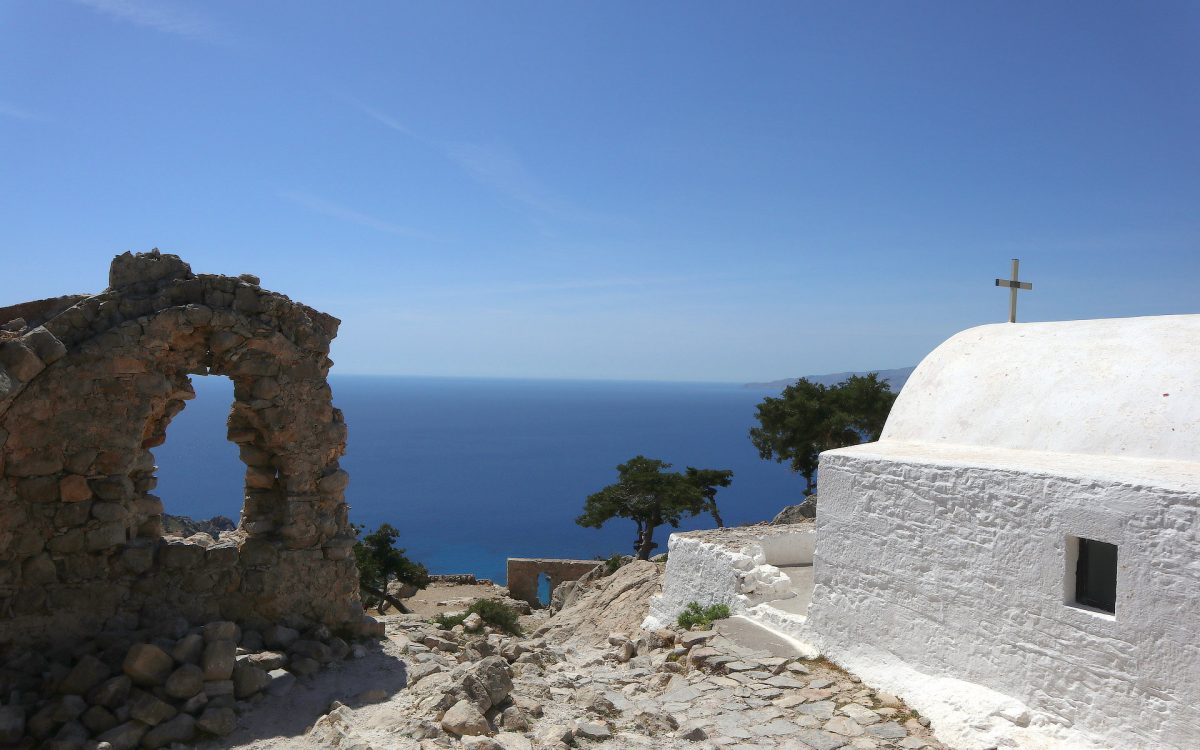Rhodes (Greek: Ρόδος) is the largest of the Dodecanese islands of Greece and it is also the island group’s historical capital.
Historically Rhodes was famous for having one of the “Seven World Wonders of the Ancient World”, the “Colossus of Rhodes”.
The island is around 80 km long and 38 km wide with approx. 1400 square kilometres and a shoreline of around 220 km.
Rhodes has a mildclimate and the dry season is between April and November, so this is basically the best timeframe to visit this beautiful island. There is a constant wind blowing on Rhodes, which makes the hot and dry summer months more comfortable.
Short History
Although Rhodes was already inhabited in the Neolithic period, there are very little remains of this culture. The island went through different eras named after the invading forces of the appropriate time.
It all started with the Minoan Era in the 16th century BC, went on to the Mycenaean Era starting in the 15th century BC, over to what is called the Archaic Era which started in the 8th century BC and switched over to the Classical Era around 475 BC.
The Hellenistic Age started in 332 BC with the arrival of Alexander the Great and went over to the Byzantine Period around the year 395, which lasted quite long until the “Knights of Rhodes” occupied the island starting around the year 1306.
After several attacks of the Ottomans, they finally managed to take over the island in 1522 and ruled over it for almost 4 centuries. After this the Modern History of Rhodes began.
Explore Rhodes
If you’re visiting Rhodes as a part of a holiday package, you surely get the chance to book bus trips to the most famous sightseeing spots, but I definitely recommend not to explore the island with these tours and get a rental car for the time on the island instead. Traffic seems to be chaotic at times, but you will fastly adapt to the driving style and going on tours with a rental cars gives you much more freedom and you even have the chance to see places that no bus tour ever drives to.But let’s get more specific now. On the right, you can see my map with my personal must-see places on Rhodes. As I surely will return to Rhodes again in the future I will also expand the map with some more spots I definitely want to see.
The map is publicly available, so you can copy the link and use it for your own trip to Rhodes and there for the necessary navigation on the island itself.
Most of the main streets will lead you around the island and even if it seems to be that the shortest way might be the fastest, you might choose to drive around the island as the streets are much better there and also driving near the sea is just so beautiful.
But now let’s get to the entertaining stuff!
Must-see spots on Rhodes
There is so much to see on Rhodes, no matter if you’re interested in cultural, archeological or nature spots. I have gathered my most recommended ones here including some closer informations on the spots.
The city of Rhodes
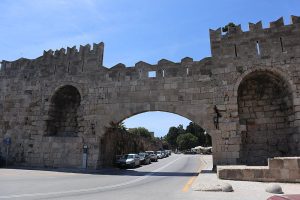 Rhodes city is the capital city of the island Rhodes and was built in 408 B.C. to be the center of Rhodes together by the Poleis Ialysos, Kameiros und Lindos. The city consists of a new part and the old town that is completely surrounded by city walls.
Rhodes city is the capital city of the island Rhodes and was built in 408 B.C. to be the center of Rhodes together by the Poleis Ialysos, Kameiros und Lindos. The city consists of a new part and the old town that is completely surrounded by city walls.
The town was built after the principles of the city architect Hippodamos with a orthogonal street grid and the three centuries after it’s creation were the golden ages of the city, where they also defeated the siege through the Antigonides (305 – 304 B.C.).
The most known architectural piece, the Coloss of Rhodes which is said to be guarding the city was standing from 282 – 226 B.C. until it was destroyed by an earthquake in 226 B.C. which also destroyed parts of the city.
In 164 B.C. the city came under the reign of the Roman Empire, but still remained to be a center of education, science and arts.
From 350 to 650 it became part of the Bycantine Empire and became an important christian and military spot. Quite a lot of churches were built during that age including several basilicas.
From 654 to 678 the city was conquered by the arabic fleet under Mauaviya, then raided in 717 by the Saracens and 807 invaded by the arabic fleet. The city started to get smaller, until the Bycantines started to build the city walls and when lateron the Venetians started to have trading posts on the island it started gaining importance and wealth again.
After some back and forth during the crusades, the Knights of St. John under the order of Grand Master Fulko of Villaret conquered the island in 1306 and made it their stronghold for expaning their power throughout the whole aegean surroundings.
With the expanded city walls they were able to withstand several attacks of the Ottomans, until the last huge siege of the Ottomans which ended on the 1st of January 1523 with the capitulation and departure of the Knights.
The Ottomans evicted a lot of the existing christian and greek population from the island and the island was losing it’s importance as trading place.
In the 19th century the island faced a lot of earthquakes and also the downfall of the Ottoman Empire, where it was conquered during the Italian-Tuskish War in 1912. After this the Italians destroyed most of the Ottoman’s influences and architecture on the country and restored a lot of the knight’s architecture including the Grand Master’s Palace.
1947 the island went back to Greece and in 1960 the medieval city was declared to be under monument protection.
The Palace of the Grand Master of the Knights of Rhodes
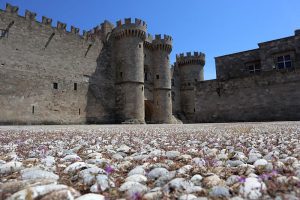 The palace is an medieval castle in Rhodes City, that is also know as the Kastello (Greek: Καστέλο) and is one of the greatly preserved examples of gothic architecture in Greece.
The palace is an medieval castle in Rhodes City, that is also know as the Kastello (Greek: Καστέλο) and is one of the greatly preserved examples of gothic architecture in Greece.
The palace was initially built as a Bycantine citadel and after the Knights Hospitallers conquered and occupied Rhodes in 1309, they converted the citadel in their administrative castle and palace of their Grand Masters. During the 14th century the palace was modified and it was also damaged in the earthquake of 1481, but constantly kept in a good condition by the knights order.
After the Ottoman Empire conquered Rhodes in 1522, it was used as a headquater and fortress.
During the italian age of Rhodes, it was restored by the italian architect Vittorio Mesturino from 1937 to 1940. Lateron it became a holiday residence for Victor Emmanuel III and later for Benito Mussolini.
In 1948, when Rhodes and the other dodecanese islands were transfered back to Greece, as agreed in the peace treaty with Italy on the 10th of February 1947. The palace was then converted into a museum.
The palace is a must-see in Rhodes city and it’s a impressive building even from the outside. The inner courtyard shows statues from the greek and roman period. Entering the museum with the huge stairway gives you the opportunity to explore just some of the 150 rooms of the palace. The exhibition shows a lot of every day objects of the medieval life and much more.
Recent studies suggest that the area the palace was built was the place of an ancient Temple of the sun god Helios and that this exact spot was probably also the original standing place of the Colossus of Rhodes.
Odos Ippoton – The medieval street of the knights
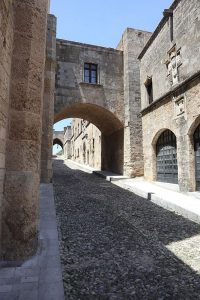 The medieval street of the knights is a 250 metre long street in it’s original state, which is located between the Palace of the Grand Masters of the Knights or Rhodes and the church Panagia tou Kastrou.
The medieval street of the knights is a 250 metre long street in it’s original state, which is located between the Palace of the Grand Masters of the Knights or Rhodes and the church Panagia tou Kastrou.
Even if the houses of the streets were partly transformed into living houses during the Ottoman period, the houses got restored using old paintings and sketches back to it’s original state during the time when Italy ruled the island.
There are still the coat of arms of the knights orders and the Grand Masters on the houses in medieval times. Most houses are the knights’ orders houses and the most beautiful one is without a doubt the “Auberge de France”, that was built in 1492 and today houses the french embassy.
The street itself is also in an original state and can be quite slippery, so you shouldn’t wear to slippery shoes.
The street is one of the pieces in Rhodes city that was declared an UNESCO world heritage site.
The best time to visit the street is the early morning or the late afternoon, as most of the tours are there between 10:00 and 15:00. So outside of this timeframe you get the perfect impression of the street and can create beautiful photos.
Archeological Museum
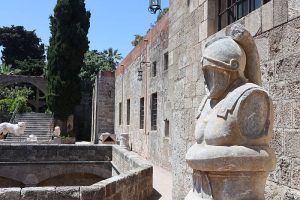 The Archeological Museum of Rhodes is located in the monumental edifice that was the hospital of the Knights of St. John in medieval times.
The Archeological Museum of Rhodes is located in the monumental edifice that was the hospital of the Knights of St. John in medieval times.
The construction of the building complex was started in 1440 and brought to completion during the reign of the Grand Master d’Aubusson (1476-1503).
The museum complex is a wide area with stairs and gardens and rooms which is so wonderful to wander around and explore the various collections of archaeological artifacts from various parts of Rhodes and the neighbouring islands, including the Statue of the Crouching Aphrodite (1st century B.C.), which was inspired by a work created by the sculptor Doidalsas in the 3rd century B.C. and also the Pyxis of the Fikellura (Mid-6th century B.C.).
It is definitely one of the most beautiful museums I’ve been to, because of the diversified area. Every time I’m on Rhodes I just have to go there and have some relaxing reading time in the garden, where you can always find a silent spot.
The Acropolis of Rhodes City
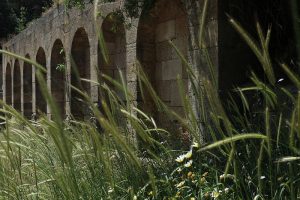 In 408 B.C., at the almost end of the Peloponnesian War, three of the island’s ancient cities merged to build the City of Rhodes.
In 408 B.C., at the almost end of the Peloponnesian War, three of the island’s ancient cities merged to build the City of Rhodes.
The remains you can see around 3 km from the center of todays city of Rhodes was the Acropolis of this newly formed city, spreading over 12.500 square meters and is nowadays protected from building activity.
The original excavations were done from 1912 to 1945 by the Italian School of Archeology in Athens and then were continued in 1949 by the Greek Archeology Service, because of the World War II. Unfortunately were some of the extensive restaurations like the Temple Pythian Apollo destroyed by bombing and artillery installation.
The Acropolis that was built on the highest part of the city was concepted in terraces and hold the following monuments:
The Temple of Athena Polias and Zeus Polieus
Located at the northern edge of the Acropolis this huge temple was dominated by Doric columned porticos on all sides and originally housed the written treaties the Rhodians held with other states.
The Temple of Pythian Apollo
This one has been a lot smaller than the Temple of Athena Polias and Zeus Polieus. It is located on the southern end of the area. Part of the northeast side of this temple has been restored.
The Nymphaeums
Right southeast of the Temple of Athena Polias and Zeus Polieus there are four subterranean platforms cut into the rock, featuring steps, paths and a large opening in the central roof. It features some water cisterns, foliage and niches for statuettes. This place was used for worship and recreational purposes.
The Odeon
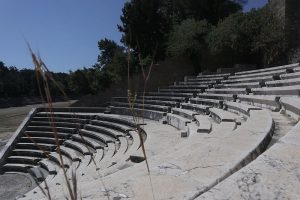 This small odeon held approximately 800 spectators and was restoreated to a very good state. Situated right beneath the Stadium, it is believed to have been used for musical performances and rhetoric lessons.
This small odeon held approximately 800 spectators and was restoreated to a very good state. Situated right beneath the Stadium, it is believed to have been used for musical performances and rhetoric lessons.
The Stoa building
The impressive facade was visible from even the harbor. Today unfortunately just one foundation wall remains to be visible.
The Artemision
The Artemis cult’s place of worship is situated on the northeast side of the hill, amidst the ruins of other structures of similar function. Little is known about the other structures by now.
The Stadium
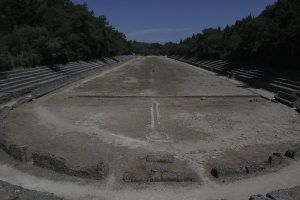 This wonderfully preserved 210-metre north-south Stadium was initially restored by the Italians.
This wonderfully preserved 210-metre north-south Stadium was initially restored by the Italians.
Its surviving features include the sphendone (rounded end with turning post), the proedries (officials’ seats) and some of the spectator seating. The starting apparatus used in the athletic events has also been preserved.
Athletic events of the Haleion Games, honoring Helios, were held here. The Stadium is in good shape and sitting there makes you really feel history come alive. Such a wonderful place.
Castle Feraklos
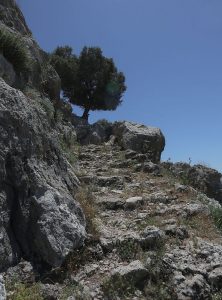 On the east coast of Rhodes, near the small village of Charaki, on a 85m high hill, the ruins of the medieval Fortress called Castle Feraklos (Greek: Kάστρο Φεράκλου) are located.
On the east coast of Rhodes, near the small village of Charaki, on a 85m high hill, the ruins of the medieval Fortress called Castle Feraklos (Greek: Kάστρο Φεράκλου) are located.
Even though there are much older parts on the hill from ancient times, the fortress itself was built in the Byzantine era and taken over by the Knights of Rhodes on the 20th of Septembre 1306. This is especially important to mention, as this was the first base on the island by the Knights Hospitallers. 100 years later, in 1408 the fortress was in ruins and then rebuilt under the Grand Masters Giovanni Battista Orsini (1467–76) and Pierre D’Aubusson (1476–1503) to secure and protect the island and it’s nearby settlements.
With the year of 1470, the fortress was one of the three remaining strongholds of the Knights of Rhodes on the island and also used as place to stay during dangerous times for the surrounding villagers.
In 1523 there was a long siege (2 months) with 450 Knights together with 2.000 soldiers (from Italy and France) defending the fortress. The castle was captured by Suleiman the Magnificent of the Ottoman Empire, that had an army of 100.000 soldiers under the command of Mesih Pascha. During the attack all residents of the fortress were slaughtered and the villages surrounding the castle were abadoned for generations.
The castle wasn’t used by the Ottomans or the people of Rhodes and was slowly falling apart during the following centuries.
The castle was built in an irregular polygonal layout, with a wall perimeter of 680m. The fortress itself spread over an area of 1.700 square meters. The walls on the north and west date to Byzantine times, but the rest are additions or modifications by the Knights Hospitallers. on the northern side a single gate and two cylindrical towers survived to modern times, along with a big cistern in the inner fortress.
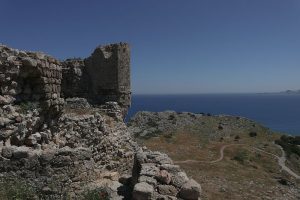 I was amazed, standing on the top of the hill inside the castle walls looking around me, by the sheer size of the fortress. This must have been an impressive castle back then, built at a perfect spot to overview the sea and the surrounding areas and settlements.
I was amazed, standing on the top of the hill inside the castle walls looking around me, by the sheer size of the fortress. This must have been an impressive castle back then, built at a perfect spot to overview the sea and the surrounding areas and settlements.
The view over the aegean sea from the fortress is breathtaking and especially during the spring times the inner fortress has a lot of beautiful flowers that make this ruin a really beautiful place to see.
Please be sure to wear good trekking shoes as the old stone stairs that lead to the castle are slippery and show strong signs of decay.
Another special thing that belongs to the fortress are tunnels under the hill. The entrances of the tunnels that go in a circle under the castle can be done with good flashlights. There are some bats in there, so please be careful and don’t get anxious. There is not much to see in there, but it’s a nice small “adventure”, especially for kids.
Castle Monolithos
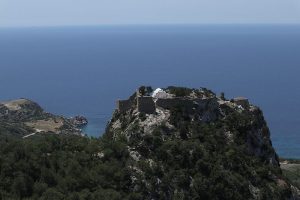 The ruins of the Castle of Monolithos are on an 236 metre high rock outside of the small town Monolithos. It is reachable through a starway that has been carved into the rocks. Although it is not steep, the stairs are partly slippery, so good shoes are recommended.
The ruins of the Castle of Monolithos are on an 236 metre high rock outside of the small town Monolithos. It is reachable through a starway that has been carved into the rocks. Although it is not steep, the stairs are partly slippery, so good shoes are recommended.
When first arriving at the top of the rock, the view over the surrounding land and aegean sea is simply breathtaking. Perfect photo spot!
On the rock during Classical times there was a frycotry and later a Byzantine Castle, that was restored in 1480 by the Knights of Saint John under the order of the Grand Master Pierre D’Aubusson (1476–1503).
It was renovated, after overcoming the difficulties of transporting the materials onto the rock, to protect the island from attacks. It’s extremely challenging accessibility made it one of the most important strongholds of the knights and even though the Ottomans tried, it was never conquered.
Finally after the siege of Rhodes in 1522, when the Ioannites departed from the island, it is assumed that it finally lost its usefulness during the 17th century with the weakening of piracy. Since it’s location made it also hard to maintain, it was slowly abandoned.
The castle itself is widely ruined and just some parts of walls and buildings are left. The rock is nowadays covered by beautiful trees and you can also find the ruins of the chapel St. George on one of the edges of the ruins.
The beautiful small chapel Agios Panteleimon is right inside the castle ruin walls and it is still in active use and is also shown on the article header photo. Absolutely beautiful!
Lindos
Coming soon.
St. Paul’s Bay
Coming soon.
The Acropolis of Lindos
Coming soon.
Jacob’s Canyon
Jacob’s Canyon is located between Siana and Embona. It’s entrance is located directly at the road in one of the curves of the road.
The best way to get there is by car and there is a small kind of parking lot directly beneath the road.
Please be sure to cross the road at a place that allows to clearly see if a car is approaching, because the drivers tend to be fast at this section of the road. In the curve of the road itself you can easily climb down to the entrance of the canyon.
The first approximately 75m of the canyon can easily done with just some rocks to climb, but then it gets much more difficult and you should be having good hiking or climbing shoes and much more important: You have to be sure, you will be able to climb down after you reached the end of this beautiful canyon.
The rock formations of the canyon remind a lot of the famous canyons in the United States. Although this canyon is a lot smaller than the big brothers in the US, this is extremely beautiful to be there with all the nature noises around you. I even “met” some wild bees and a huge hornet there.
When you reach the end of the canyon you will be almost on top of the whole mountain. I don’t recommend to try to clim the last metres of the canyon as there are a lot of loose stones and it’s also getting very steep.
Be sure to have sufficiend water with you. Even if it is colder on the bottom of the canyon it’s rapidly getting warmer when you climb up.
This sightseeing spot is definitely for the people seeking extraordinary places away from the main paths ordinary tourists are visiting.
Kritinia Castle
Coming soon.
Anthony Quinn’s Bay
Coming soon.
Ancient Kameiros
Coming soon.

